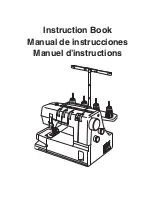
Sewing Various Fabrics
Sewing
S-5
SE
W
IN
G
A
T
T
R
A
C
T
IVE F
IN
ISHES
S
Sewing thin fabrics
When sewing thin fabrics such as chiffon, the stitching may
become misaligned or the fabric may not feed correctly. Move
the needle (be sure to use a fine needle) to the furthest left or
right hand position so that the fabric does not get pulled down
into the feed dog area. If this occurs or there is shrinkage of
the stitching, place non-woven water-soluble stabilizer under
the fabric and sew them together. Using the straight stitch
needle plate* and straight stitch foot* is also effective when
sewing thin fabrics.
* Sold separately with some models.
1
Water-soluble stabilizer (non-woven)
Sewing stretch fabrics
First, baste the pieces of fabric together, and then sew without
stretching the fabric. If the stitching is misaligned, place non-
woven water-soluble stabilizer under the fabric and sew them
together.
1
Basting
For best results when sewing on knit fabrics use the stretch
stitches. Also be sure to use a needle for knits (Ball point
needle (gold colored)). The recommended stitches and their
stitch numbers are indicated below.
* Stitch patterns can be selected directly by pressing the
numeric keys on the machine during preset utility stitch
mode. Refer to “Basic operations” section.
Sewing leathers or vinyl fabrics
When sewing fabrics that may stick to the presser foot, such as
leather or vinyl fabrics, replace the presser foot with the
walking foot*, non stick foot* or roller foot*.
* Sold separately with some models.
1
Leather
If the leather or vinyl fabric sticks to the flat bed attachment,
sew with copy paper or tracing paper placed on top of the flat
bed attachment so the fabric moves smoothly.
If the paper is positioned so that it does not cover the needle
plate, the paper will not be sewn together with the fabric.
1
Copy paper or tracing paper
Stitch
Model 4
1-05
1-06
1-13
1-14
2-13
Model 3, 2
05
*
06
*
13
14
*
48
Model 1
05
*
06
*
11
12
*
42
1
1
Note
• The walking foot can only be used with straight
or zigzag stitch patterns. Do not sew reverse
stitches with the walking foot.
• When sewing with the walking foot, sew at a
speed between slow and medium.
• When using the walking foot, test sew on a scrap
piece of leather or vinyl that is to be used in
project to make sure foot does not leave any
marks.
1
1
















































